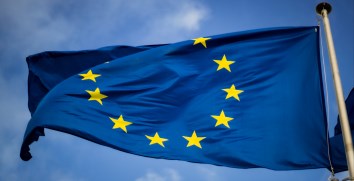ABSTRACT
The aim of this research paper is the study of legal status of the European company, reflection of preconditions for creating a new legal form of a company, which has a European origin, the identification of features of the legal regulation of its establishment and operating activities, as well as the analysis of the advantages and drawbacks of these legal entities, which define its effectiveness for large business and prospects.
The methodological basis of the research is historical, comparative-legal, particular-legal analysis, as well as secondary data analysis.
One of the most important findings is that supranational legal entities are one of the most promising organizational legal forms of business in the territory of the EU Member States. Among them the European company has received the most attention from business and suitable development. The Regulation on the Statute of the European company vest this European legal form with the prominent features of supranational legal entity. At the same time, this Regulation allows the foundation of legal entity which has a supranational character.
The European company initially was created to develop competitive benefits for large businesses. It has several advantages that may ensure the growth of activities and the development of this legal form in the EU. But when comparing the benefits of European company with its drawbacks, it should be recognized that at the moment the drawbacks are more meaningful for business community. The influence of external factors as well as decline of profitability of companies over the world in the last years also play an important role in the perspectives of the development of European companies.
The research paper presents the conclusions and suggestions which can be suggested as key factors and potential solutions for business.
INTRODUCTION
The regulation of supranational legal entities has become increasingly significant in the process of modernization of company law in the European Union (hereinafter – EU) and ensuring sustainable economic growth of the EU Member States. This is justified by the fact that the creation of new organizational legal forms of entities under EU legislation allows companies from different Member States carrying out commercial activities in the territory of the EU and obey common rules regulation.
In modern conditions of European integration supranational legal entities are recognized to be one of the promising organizational legal forms of business in the territory of the EU. There are three supranational legal entities created – the European Economic Interest Grouping, the European Company (hereinafter – SE) and the European Cooperative Society.
The SE is a typical example of the interplay between law and economic interest. The provisions of the Regulation on the Statute of the SE are created to ensure competitive advantages for large business. The SE offers some significant benefits such as the possibility to reduce costs because of simpler structure and tax regulation. However, it should be recognized that the drawbacks are more meaningful for business community.
The creation of SEs contributed to solving the problem of the mobility of companies across the EU, thus, opening new opportunities for business. At the same time, the problem of establishing compliance of legal persons to the status of supranational companies was formed, as well as the effectiveness of the application of this organizational legal form for commercial activity by entrepreneurs.
At the present stage of formation of economic processes and particularly of activity of the SE, it became clear that for the development and further use of this organizational legal form of legal entity it is necessary to improve its attractiveness to ensure business with new competitive advantages.
The prospects of the SE development depend on the variety of factors: starting on changes to existing SE legislation to make it more convenient for entrepreneurs till formation of new forms of supranational legal entities.
Whereas large business is interested in profit and increase of market share, one of the most important factors, which might prejudice the perspectives of the development of SEs, are the reduction of founding costs and administrative burden, the reduction of subsequent costs related to the implementation of provisions of the Regulation during activity of the company and improvement of awareness of these legal entities in the business community and society.
The influence of external factors also plays an important role, especially for the large companies, which are the main drivers of economic development. The growth of global economy, the development of the real sectors of the economy and political stability might ensure positive influence on the possibilities of business development.
Studies on the legal regulation of creation and operations of SEs were performed by the following authors: Andenas M. (2009) [1], Wooldridge F. (2009) [1], Gold M., (2009) [2] Nikolopulos A. (2009) [2] and Kluge N. (2009) [2]. One should highlight the complex work of authors Cremers J., Stollt M. and Vitols S. (2013) [3] from the latest studies on the establishment and activities of SEs. An important role in the study of SE’s foundation dynamics belongs to different researches made by European Trade Union Institute., as well as specified research conducted by the company Ernst &Young.
DISCUSSION AND RESULTS
The process of harmonization of legislation on legal entities of Member States of the EU and the creation of new supranational legal entities took an important place in the formation of the corporate law of the EU. The significance of the creation of supranational legal entities was caused by the necessity to achieve the main objectives of regulation of legal persons in the EU law. First, the freedom of establishment of legal entities in the territory of any Member State of the EU. Second, the establishment of minimum common requirements for legal persons. Third, the provision of the same protection to participants and creditors of legal persons throughout the EU, as well as benefit to the companies’ business activities through the elimination of differences between national legal systems. Furthermore, one of the practical reasons for the creation of these legal forms was the intension to solve the issue of changing the location of a company within the EU without the need for passing the liquidation procedure of the company in the state of its original location.
The drivers of economic development and growth of GDP are large companies. Therefore, the main attention was focused on stimulating their activities across the EU Member States. In turn, this has led to the fact that the SE took the central place in the process of formation of supranational legal entities.
The first concepts of an SE were launched in the 1960s, however, only after more than 40 years of discussions, additional researches and numerous changes, the European company legislation entered into force. Council Regulation EC 2157/2001 of 8 October 2001 on the Statute of the European company [4] came into force on 8 October 2004, together with the complementary Directive 2001/86/EC on worker participation in the management of the European company [5].
The SE is an organizational legal form of legal entity that allows a company to operate in different Member States of the EU under a single statute. The Regulation vest the SE with the prominent features of supranational legal entity. First, whereas the Regulation is directly applicable legal act, the SE has legal personality and full legal capacity in all Member States of the EU. Second, the SE has a cross-border dimension in terms of carrying out activities in at least two Member States of the EU, as well as there is an availability of cross-border component for the foundation of the SE. Third, the ability of the SE to transfer its registered office from one Member State of the EU to another without the need for winding up of the SE or the creation of a new legal entity.
At the same time, it should be noted that an SE would not be fully supranational company, but rather has a supranational character. To a large extent this is because of the significant influence of the applicable national law of the EU Member States in the management of SEs activities and because of the lack of unified rules for governing all aspects of the activities of these legal entities.
Among the first SEs were such famous market leaders as Allianz SE (Germany) and Elcoteq SE (Luxembourg). In subsequent years Airbus Group SE (Netherlands), Bombardier Transportation Global Holding SE (Netherlands), Christian Dior SE (France), Groupe Eurotunnel SE (France), LVMH Moët Hennessy Louis Vuitton SE (France), MAN SE (Germany), Porsche Automobil Holding SE (Germany), Wiener Privatbank SE (Austria), Würth SE (Germany) were registered as SEs [6]. Presently some large companies such as Capgemini SE (France), Deutsche Börse AG (Germany) and GK Software AG (Germany) are also in process of registering themselves as an SE [7]. According to European Trade Union Institute (hereinafter – ETUI) data there are 2.757 SEs registered until 31 March 2017 [8]. Therefore, the SE is the most common organizational legal form of legal entities under EU law.
An SE has legal personality in each Member State of the EU. Besides other questions not regulated by the Regulation on the Statute of the SE, it is governed by the national provisions applicable, under the same conditions, to public limited-liability companies of that Member State of the EU, in which it has its registered office.
The subscribed capital of the SE shall be divided into shares and shall not be less than 120.000 euro. It should be noted that shareholders are not liable for more than the amount of the subscribed capital [1].
The formation and activities of an SE are governed by the Regulation on the Statute of the SE and, where expressly authorized by this Regulation, by the provisions of its statutes. In the case of matters not regulated by this Regulation or, where matters are partly regulated by it, of those aspects not covered by it, SE operations are governed by:
1) the provisions of laws adopted by Member States in implementation of the EU measures relating specifically to SEs;
2) the provisions of Member States’ laws which would apply to a public limited-liability company formed in accordance with the law of the Member State in which the SE has its registered office;
3) the provisions of its statutes, in the same way as for a public limited-liability company formed in accordance with the law of the Member State in which the SE has its registered office [4].
The Regulation on the Statute of the SE imposes the provisions, which define the of formation of an SE. As opposed to European Economic Interest Grouping, an SE may be formed only by at least two legal entities from different Member States of the EU. Furthermore, these legal entities must be formed under the law of the EU Member State with registered office and head office within the EU [2].
The Regulation imposes the following methods of an SE set up. The first method is the merger of two or more existing public limited companies from at least two different Member States of the EU. The second method is the formation of a holding company promoted by public or private limited companies from at least two different Member States of the EU. The third method is the formation of a subsidiary by companies from at least two different Member States of the EU. The fourth method is the transformation of a public limited company which has had, for at least two years, a subsidiary in another Member State of the EU [1]. The fifth method of formation of an SE consists of the foundation of a fully-owned subsidiary SE by a parent SE [9].
Initially, the merger seemed to be the most applicable method of SEs’ foundation for large European industrial companies. However, analysis of the forms of foundation leaves no doubt about the preferred method of registering an SE. On March 2017 about 79% of SEs have been set up by subsidiary, but only 4% – by merger [8].
The problem of choosing the structure of managing bodies of an SE was one of the significant obstacles that were not allowed to adopt the Regulation on the Statute of the SE, because of differences in the internal structure of the companies in the national legislations of the EU Member States. It should be noted that several Member States do not have a dualistic system for their national public limited-liability companies, for example, Belgium and Sweden. At the same time, several Member States do not have a monistic system for their national public limited-liability companies, for example, the Czech Republic and Latvia. As a corollary to this, the Regulation provides for a flexible system of an SE management by allowing to choose between a two-tier and a one-tier system. In accordance to ETUI data about 82% of SEs have chosen a dualistic system with a separation of the functions of the management body, which is responsible for managing the SE and the supervisory body, which supervises the work of the management body and may not itself exercise the power to manage the SE [8].
The Regulation imposes that the registered office of the SE should be located within the EU, in the same Member State as its head office. In addition, a Member State may establish for an SE registered in its territory the obligation of locating its head office and its registered office in the same place [4]. The requirement of the coincidence of the registered office and the head office location of an SE is to avoid competition between the national legislations about the most convenient legal regime for SEs.
The Regulation establishes detailed legal provisions of the transfer of the registered office and guarantees the legitimate rights and interests of creditors, state authorities and minority shareholders of the company. It sets out the mechanism for transfer implementation, includes the requirements for the publication of information on the transfer, provided the state control and the necessity of the notification of the registration authority in the former location of the SE. In accordance with ETUI data about 4% of SEs transferred the registered office to another Member State of the EU [8]. This fact confirms the complexity and high cost of the process of the transfer of the registered office or head office of the SE.
One of the most complex questions was related to the participation of employees in management of the SE. This was due to the existence of serious differences in national legislations of the EU Member States. Thus, employees’ participation is allowed in management of companies in some form in most of the Member States of the EU. For this reason, two legal acts, namely, the Regulation that govern the organizational and legal activity of the SE and the Directive that regulates the participation of employees in management of the SE, were created. The main goal of the Directive is to ensure guarantees of an adequate level of involvement of employees in the affairs of the newly created SE based on principle of protecting existing rights [3].
Among large companies and small and medium-sized enterprises (hereinafter – SME) only entrepreneurs representing large business have a possibility to create an SEs. It became possible because the Regulation on the Statute of the SE entered into force, but Proposal for a Council Regulation on the Statute for a European Private Company was withdrawn. Moreover, the Regulation on the Statute of the SE was created with the aim of developing competitive advantages for large business. First, the Regulation is directly applicable legal act. It means that SEs from different Member States not only are governed by the same Regulation provisions, but also have possibility to change the location of a company within the EU Member States without the need for passing the liquidation procedure in the state of the original location. Consequently, large companies are permitted to receive a significant cost reduction, increase of profitability, attraction of investments and further business development. Second, the requirement for minimum subscribed capital of an SE, established in the amount of 120.000 euro, is acceptable mainly to large companies. Third, SEs receive a possibility to use different structures of managing bodies, even to choose such management structure, which is not allowed for national public limited-liability companies by the national legislation.
The existing provisions of the Regulation provided the SEs with certain advantages and drawbacks, as well as identified areas for further improvement of legislation to encourage the formation of the SEs and stimulate their activities. The most important advantages of the SE are the following:
1) the possibility to transfer the registered office became a major advantage of the SE and a strong incentive for choosing this legal form. The importance of this advantage is particularly high for SEs and companies incorporated in the EU Member States that do not allow companies to transfer their registered office outside their jurisdiction or in which such a transfer would result in the winding-up of the company in the departure Member State and new incorporation in the arrival Member State [9].
2) “European label” is deemed to be one of the most significant advantages of the SE. It gives the company a strong European image and became attractive for companies that intend to highlight their European nature or focused on new market penetration in other Member States of the EU. However, it should be noted that in some specific sectors national brand is more valuable in some Member States of the EU.
3) the possibility to choose national tax regime for setting up an SE. Tax advantages is the determining factor of the activities of companies, because of significant influence on the overall financial results. Despite the Regulation does not contain special provisions on the taxation of SEs, these companies have two means to receive tax advantages. The corporate income tax calculation is defined as financial result of all operations of the SE in different Member States. Thus, the SE has opportunity to offset the profit gained on the territory of one Member State and losses from the activities in the territory of another Member State. Strong differences between the rates of corporate income tax in the different Member States also became a point of interest for companies. It should be noted, that analysis of possible tax advantages related to the transfer of registered office of an SE cannot, however, be limited to corporate income tax. By deciding to transfer registered office to another Member State, it should consider other significant taxes: capital gain tax and withholding tax.
4) the possibility to simplify the organizational structure of the SE. By effective formation of the structure of the company, entrepreneurs can set up a unified management and reporting system of the company, reduce administrative costs and, therefore, improve the profitability of the company.
According to statistics, the total number of the registered SEs is increasing annually. On the one hand, it is not deniable that this fact is a positive. Indeed, only 96 SEs were registered on 8 September 2007 [2], 2.125 SEs – on 21 March 2014 [10], and 2.757 SEs – on 31 March 2017 [8]. On the other hand, the number of registered SEs over the past years indicates a tepid interest in this legal form of legal entity. In this regard, it is useful to highlight a few main reasons:
1) the SEs are legal entities under the EU law of supranational nature, because of significant influence of the applicable national law of the EU Member States in regulating their activities. Therefore, the SE gets its own national characteristics in each Member State, due to different legal regulation of the activities at the national level.
2) there is the need to attract substantial funds in the formation of an SE. According to the data obtained as a result of ongoing research upon the request of the European Commission, the total expenditure on the formation of an SE, including the costs of legal services, translation and registration, can reach 2-4 million euro [11].
3) the lack of awareness of SEs among the business community is also a serious drawback in the spread of this legal form of legal entity in the EU Member States. In announcing the adoption of an SE, companies often incur additional costs associated with the explanation of legal nature of SE among its business partners and employees.
4) the possibility to transfer the registered office of the SE from one Member State of the EU to another is not so clear-cut advantage of the SE. It also has a negative impact on activities of the SE, because the transfer of the registered office or head office is time consuming and expensive process.
5) the statutory requirement of location of the registered office and head office of an SE within the same Member State significantly restricts the mobility of the SEs, because of inability to transfer head office without the transfer of its registered office.
6) the procedure relating to the negotiation of employee involvement in the management of the SE is regarded as a complex procedure and, therefore, often has seen as a drawback for formation of an SE. [9].
Nowadays the SEs have not encountered the success initially expected. Therefore, it became apparent that it is necessary to increase the attractiveness of the SEs for business community. Their further development will not be effective without making changes to existing legislation. It is not only linked with the possible amendments of the Regulation and the Directive. The other legal acts dedicated to new forms of supranational legal entities are of high importance.
Unfortunately, all last four initiatives on new supranational legal form formation were withdrawn. The Proposal for a Council Regulation on the Statute for a European Foundation joined the other three proposals (for a European association, for a European mutual society and for a European Private Company), which were withdrawn by the Commission due to lack of progress in the legislative process and deficiency of progress to reach an agreement. Additionally, the Commission’s Work Programme 2015 and Work Programme 2016 did not contain any proposals for new European legal forms.
It should be noted that negotiations between the EU and the United States of America on the Transatlantic Trade and Investment Partnership (hereinafter – TTIP) have essentially failed also. TTIP is about reducing the regulatory barriers to trade for big business, things like food safety law, environmental legislation, banking regulations and the sovereign powers of individual nations. In fact, TTIP is an assault on European and US societies by transnational corporations. Some of them have SE’s form.
Considering all the above one can assume that the formation of the SEs by large business will happen. In the EU Member States within highly developed economies, such as Germany or France. In other Member States, most of the national companies will tend to be SMEs and prefer not to engage in the process of establishing an SE.
CONCLUSION
Summing up the above mentioned about the SE, it is important to note the following:
1) The SE is the most popular legal form of supranational legal entities. The Regulation on the Statute of the SE vest the SEs with the prominent features of supranational legal entities. At the same time, the Regulation allows the foundation of legal entities, which have a “supranational” character.
2) The SEs ensure significant competitive advantages for large business. Moreover, only SEs can take advantages of supranational legal entities. Therefore, large companies have unequal competitive position comparing to SMEs that allows to increase the profitability, attract new investments and continue business development.
3) The SE offers some significant advantages. Among the most relevant advantages are the following. First, the possibility to transfer the registered office from one Member State of the EU to another without the need for passing the liquidation procedure in the state of its original location. Second, the possibility to reduce costs because of unified and simpler management structure and tax regulation.
4) When comparing the benefits of the SE with its drawbacks, it should be recognized that the drawbacks are more meaningful for business community. One the most significant disadvantages is the legal uncertainty of the formation of an SE. The substantial costs of the foundation of an SE, as well as the subsequent costs of compliance with company rules set in the Regulation already in the process of functioning of the company also have negative impact on the development of the SEs.
5) The attractiveness of the SEs for business community needs to be enhanced by making changes to existing legislation. The formation of the SEs by large business is expected to continue in the EU Member States with highly developed economies mainly because of influence of external factors. The most important factors that might predetermine the future development of the SEs just as other legal entities under the EU law are the reduction of founding costs and administrative burden, improvement of awareness of new organizational legal forms of supranational legal entities in the business community, as well as the positive influence of economic growth and development of the real sectors of the economy and political stability.
REFERENCES
[1] Andenas M., Wooldridge F. European Comparative Company Law. Cambridge: Cambridge University Press, 2009.
[2] Gold M., Nikolopoulos A., Kluge N. The European Company Statute: a New Approach to Corporate Governance. Bern: Peter Lang AG, 2009.
[3] Cremers J., Stollt M., Vitols S. A decade of experience with the European Company. Brussels: European Trade Union Institute, 2013.
[4] Council Regulation (EC) No 2157/2001 of 8 October 2001 on the Statute for a European company (SE). Official Journal of the European Union. No L 294, 10.11.2001.
[5] Council Directive 2001/86/EC of 8 October 2001 supplementing the Statute for a European company with regard to the involvement of employees. Official Journal of the European Union. No L 294, 10.11.2001.
[6] The ETUI’s European company (SE) database. Established SEs. [Internet resource]. http://ecdb.worker-participation.eu/show_overview.php?letter=A&orderField=se.se_name&status_id=3&title=Established%20SEs. Retrieved 01.07.2017.
[7] The ETUI’s European company (SE) database. Companies in the process of registering as an SE. [Internet resource]. http://ecdb.worker-participation.eu/show_overview.php?letter=A&orderField=se.se_name&status_id=2&title=Planned%20SEs. Retrieved 01.07.2017.
[8] Carlson A. SE Companies in 2017. Overview of current state of SE founding in Europe. Workers' Participation Europe Network, ETUI, 2017.
[9] Study on the operation and the impacts of the Statute for a European Company (Final Report). Ernst & Young Société d'Avocats. 2009. [Internet resource]. http://ec.europa.eu/internal_market/consultations/docs/2010/se/study_SE_9122009_en.pdf. Retrieved 01.07.2017.
[10] Carlson A., Kelemen M., Stollt M. Overview of current state of SE founding in Europe. Brussels: European Trade Union Institute, 2014.
[11] Report from the Commission to the European Parliament and the Council of 17 November 2010. The application of Council Regulation 2157/2001 of 8 October 2001 on the Statute for a European Company (SE). [Internet resource]. http://eur-lex.europa.eu/legal-content/EN/ALL/?uri=CELEX:52010DC0676. Retrieved 01.07.2017.








